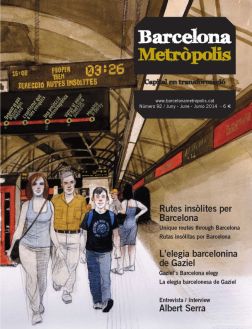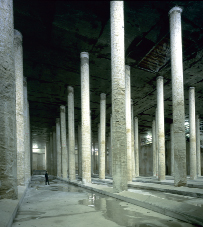Reality is very different from what we expect. The invisible and the hidden are the origin of that to be revealed. The beginnings and the raison d’être of Barcelona are hidden in its entrails, a place we cannot delve into, unless we keep a tight grip on Ariadna’s thread.
Under the plain on which Barcelona was built there runs a host of streams that have been carrying water, uninterrupted, since time immemorial, and which were used by the Romans to set up the small settlement of Barcino. To get to these natural watercourses, over the centuries a series of extremely long, man-high tunnels known as “mines” were constructed. Today, a large number of these adits are still in perfect condition. Such is the case of the mines in the Monestir de Pedralbes, Can Travi, Can Masdeu, and one in a property in Putxet.
As well as this, during different historical periods innumerable wells of various depths were dug. For example, those hidden under several houses in the Gothic Quarter and the 40m deep one that Gaudí drilled at Bellesguard. Water also accumulates in natural deposits in the belly of the Montjuïc mountain – in ancient times an island at the foot of which it is said that the mythical Hercules created the city – in small lagoons currently sealed or buried under new buildings, where local children bathed in the middle of the last century. And while clean water makes life possible, we also have to get rid of dirty water. So, Barcelona has a sewer system of over a thousand kilometres in length, parts of which are as curious as the stretch that runs under Carrer de la Bòria and Plaça de la Llana, along a section of the ancient Via Augusta, and the one in Palma de Sant Just, which is a perfectly preserved Roman example.

© Pérez de Rozas / AFB
The civil governor of Barcelona, Bartolomé Barba, giving donations to occupants of the caves of Montjuïc, in December 1945.
The Civil War shelters
The underground world is the perfect place to hide oneself, be protected in and escape to. During the Civil War, more than fourteen hundred shelters were constructed around the city to keep the population safe from the bombardments (you can visit them in Plaça del Diamant, Plaça de la Revolució and at number 307, on Carrer Nou de la Rambla at the foot of Montjuïc), but there are also hideaways from much earlier times, like the strange circular room for seven people under Pati Llimona, and the one that is thought to have been a secret meeting place for Serralonga and his henchmen, in a collapsed basement near Palau Mercader.
We could also talk about the countless passageways (of which no one dares speak out of fear or prudence) that connect many of the iconic buildings of Ciutat Vella and even go beyond the old Roman wall, tunnels that were used for escaping unseen. There is, for example, a network of galleries linking the centre of the city with Mas Guinardó (the former home of another bandit, Rocaguinarda), and there are several tunnels that even cross the Collserola range, one of which reaches the Palau de les Heures and was used by the Catalan government during the war, although today it is no longer in service.
The underworld also took refuge below Barcelona, in the famous Punta del Morrot tunnels, popularly known as the Hotel Montecarlo, and even in the sinister passages under the an old toy factory in Horta – currently known as “La Jungla” – where a horde of violent people terrorised the neighbourhood. But surely, one of the darkest facets of the urban underground are the txeques, the torture chambers used during the Civil War from which few people left with their lives.
Even so, the belly of the city has a charming and maternal side: the cave. A dark, quiet corner, perfect for meditating and finding oneself. Barcelona hides some particularly poorly known caves; we have already mentioned those of Montjuïc, but there are others that, during the 19th century, were inhabited by hermits in the Penitents neighbourhood. And we cannot forget the one discovered by Gaudí and Güell on the Carmel mountain, located precisely at the spot where the Park Güell bar, services and preservation store are today, and in which the remains of a primitive man and a mammal were found. Or, of course, the secret room known as Capelya, which the architect built under the Tres Creus hill, a sealed enclosure that can only be reached via the network of galleries that burrow through this mountain. This is an extremely long web of passageways dug out in the Middle Ages, or even before, for extracting iron. These are the so-called Xirot and Cimany caves, which give their names to a school in the area.
Finally we should mention the extraordinary grotto built by the eccentric businessman in the Americas, Altimira, under his property in Bonanova, with real stalactites and stalagmites, aquariums, skylights and a strange oval room known as the Echo. A place just for fun?
All these worlds within worlds, secret spaces, lonely, full of dangers and snares, often very close to the metro and rail networks on which we travel from A to B so often, make up an extensive maze that should be entered and explored. If we don’t let go of Ariadna’s thread, it will lead us straight to the centre, to the site of the temple of the Sagrada Familia. And we can get back out into the light.






He sido fotógrafo de investigación durante años y es muy lamentable que en mi propia ciudad haya tantos sitios interesante cerrados a cal y canto al ciudadano y que para poder visitarlos sea una odisea la mayoría de veces inalcanzable
E Pozo de Bellesguard que citas, no fué construido por Gaudí. Lo que el realizó, además de una restauración del brocal, fue la caseta que lo resguarda en forma de Dragón con dos compartimentos. Tiene 42 ms. de profundidad y una escalera de gato que permite bajar. A unos 20ms. de profundidad hay una galeria lateral que desciende hasta la Bonanova.
Ya aparece documentado en 1408 en lo que fué palacio fortaleza de Martín el Humano, pero las construciones del conjunto se remontan al presidium romano de época Claudio/Nerón que controlaba el acceso a Barcelona de la Via Augusta, del que quedan importantes restos.
¿Por donde se accede a la mina del Bellesguard?
Gracias
La referencia a Bellesguard que incluye el texto se refiere a la Torre de Bellesguard que se puede visitar
Más información: https://www.barcelona.cat/es/coneixbcn/pics/atractius/el-diposit-del-rei-marti_99400391048.html